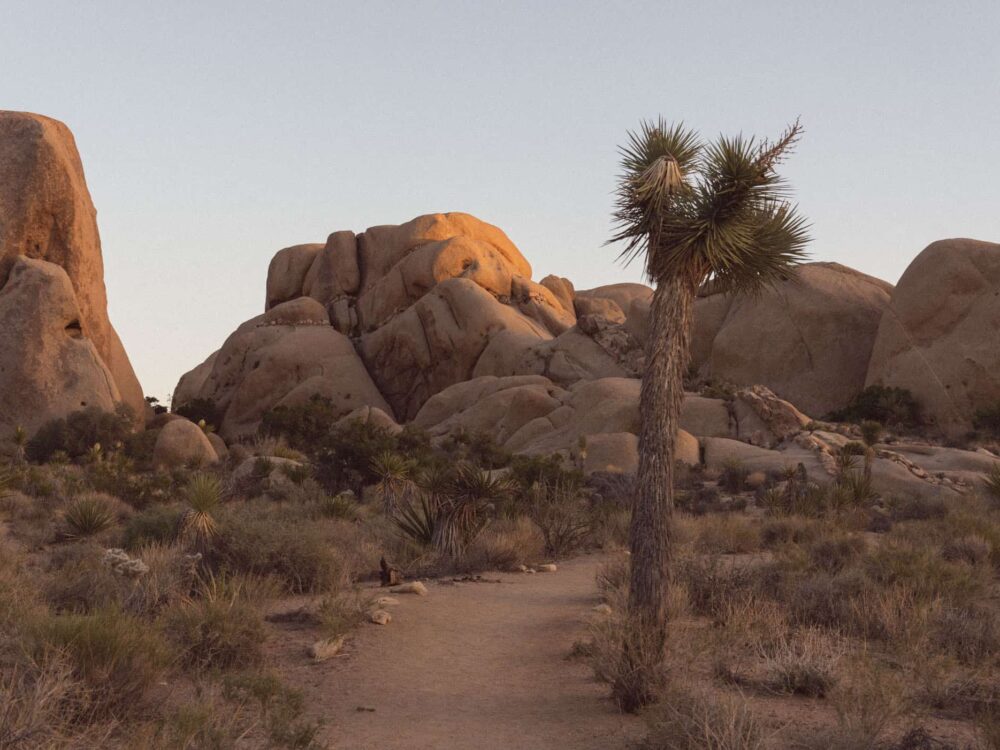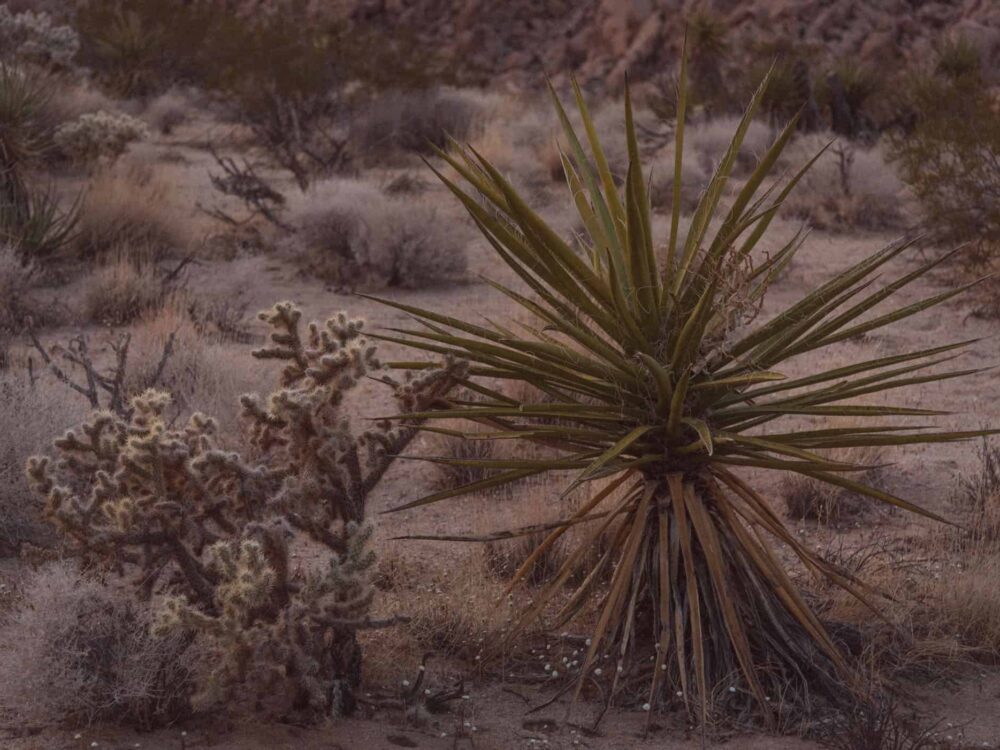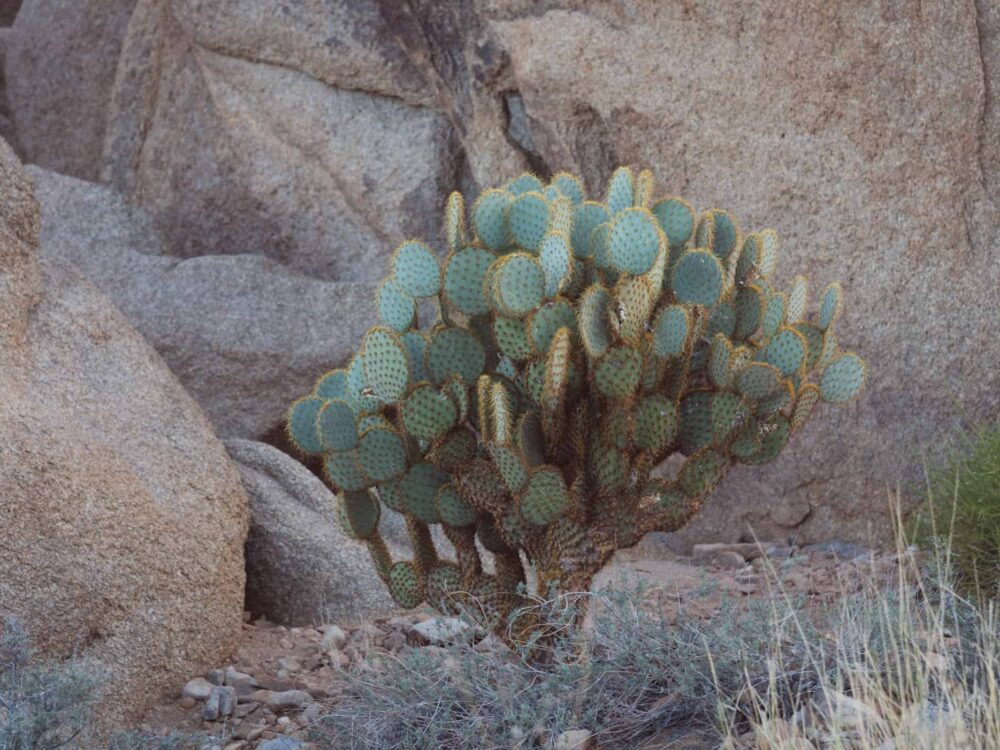Hike & Walk | Joshua Tree National Park | United States
3 Epic Hikes in Joshua Tree National Park
Text | Anninka Kraus
Photography | Tobias Kraus

US California
Joshua Tree is a marvelous national park straddling the Colorado and Mojave deserts in south-eastern California. Since a desert does not equal a desert, the park’s location just where the two fragile desert ecozones converge beautifully highlights the contrasts in scenery between the northwestern and eastern sections.
In the Mojave Desert Ecozone, at elevations above 900 meters, monzogranite boulder stacks in odd shapes lie scattered across the desert which is dotted with Mojave yuccas, pinyon pines, junipers, prickly pear cacti, and, of course, the park’s namesake yucca species, the Joshua tree. This is by far the busier half of the park, with most amenities and campgrounds located near the North and West entrances.
It’s much quieter and feels more remote in the east of the park, where the Colorado Desert habitat lies below 900m in elevation and generally appears more barren and desert-like. Unless you visit in spring when the rocky landscape looks surprisingly colorful and vibrant with all the wildflowers in full bloom. Ocotillo, for instance, a spindly desert plant that looks like an extravagant bouquet with long stems will be topped by beautiful red flowers.
Both areas of the park, but particularly the northwestern section, are astounding examples of flora and fauna that have adapted to scorching heat and water scarcity to thrive in this inhospitable environment.
An extensive trail network in the Mojave Desert area of the park makes the desert wilderness accessible to hikers and offers fabulous trails of varying length and difficulty. You could easily spend a week in the park, exploring all the different tracks and sights, but if you’ve only got a day or two, we can warmly recommend our favorite 3 hikes in the Mojave Desert section of Joshua Tree National Park: the Maze Loop, Window Rock, and North View Trails, Split Rock Loop Trail & Face Rock Spur, and Hidden Valley Trail
To make the most of your visit to Joshua Tree (and allow more time for hiking), I recommend camping in one of the park’s eight campgrounds. The most sought-after spots seemed to be Black Rock (on the park’s northwestern perimeter) and Cottonwood (the only campground in the Colorado Desert area of the park), the only two sites with water and flush toilets.
Don’t worry though, if you can’t snag a spot at either of those two campgrounds, for there are several great first-come-first-serve alternatives. See the information section below for more details.
jump ahead.
1. The Maze Loop, Window Rock, and North View Trails
Loop trail | 3 hours
2. Split Rock Loop Trail & Face Rock Spur
Loop trail | 2 hours
3. Hidden Valley Trail
Loop trail | 30 minutes +








The sunset colors in Joshua Tree are out of this world.
what to expect.
A national park straddling both the Colorado and Mojave deserts
A beautiful desert landscape studded with Mojave yuccas, pinyon pines, prickly pear cacti, and the park’s namesake yucca species, the Joshua tree
Plants and animals that have adapted to adapted to heat and water scarcity
An extensive trail network that makes this desert wilderness accessible to hikers
3 wonderful hikes & walks in Joshua Tree National Park.
The Mojave Desert is dotted with Mojave yuccas, pinyon pines, junipers, prickly pear cacti, and, of course, the park's namesake yucca species, the Joshua tree.
location & park information.
Directions: Joshua Tree National Park is located in south-eastern California, a 2:15-hour drive from Los Angeles, and 2:45-hours from San Diego. From either location, you’ll take California Highway 62 (the Twentynine Palms Highway) to access the popular Mojave Desert side of the park. The West Entrance and Joshua Tree Visitor Centre are located at Joshua Tree Village and the North Entrance and Oasis Visitor Centre at Twentynine Palms.
Best time to visit: The best time to visit Joshua Tree National Park is in the fall (September-November) and spring (March-May) when daytime temperatures are pleasant and nighttime temperatures are not yet too chilly. We visited in spring when lots of wildflowers were in bloom and splashed color on the barren rocks. The scorching heat of summer is best avoided, but the winter months are another option. The park is less crowded then but temperatures can drop below freezing.
Plan your visit: The entrance fee is $30 per vehicle for a 7-day period unless you have the annual America the Beautiful Pass ($80/1 year/2 pass owners), which covers entrance fees at all national parks and many other recreational areas in the States. The desert climate and high elevations make for cool nights and high daytime temperatures throughout the year – pack a warm sleeping bag and layers for chilly evenings as well as sunscreen and a hat.
Camping in Joshua Tree National Park: at the time there were eight campgrounds in the park, five requiring advance reservations (Jumbo Rocks, Indian Cove, Black Rock, Ryan, and Cottonwood) and three first-come, first-served campgrounds (Belle, Hidden Valley, and White Tank). Only two, Black Rock and Cottonwood, have water and flush toilets and there are no showers anywhere in the park. If you’re staying at any of the other campgrounds you can get drinking water at the Oasis Visitor Center in Twentynine Palms, the West Entrance station, and Indian Cove Ranger Station.
The camping fee ranges from $15 to $25 and even the most basic campgrounds offer vault toilets, tables, and fire pits.
We were really lucky to snatch up the last available spot in Jumbo Rocks on short notice for a mid-week stay in March, the other campgrounds were already fully booked. It’s highly recommended to reserve a site if you plan to visit on a weekend or during the school holidays in peak season, between November and May. Reservations can be made up to 6 months in advance.

